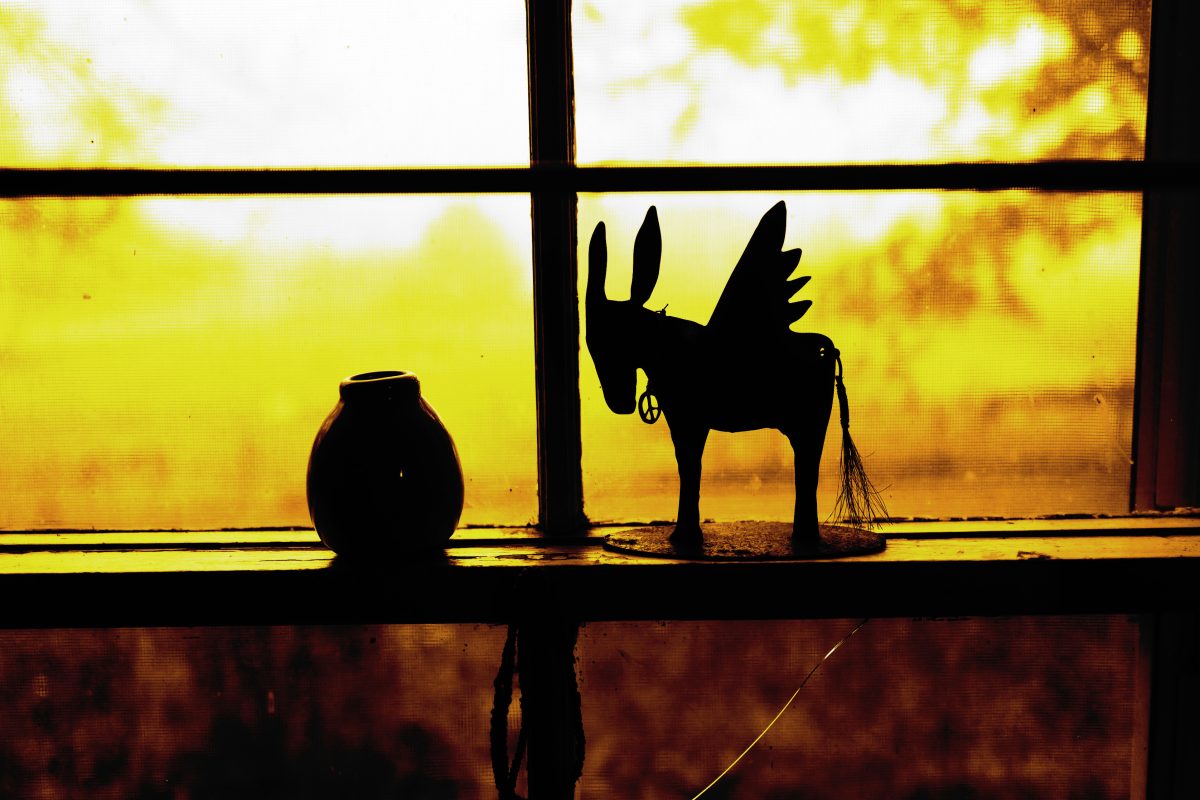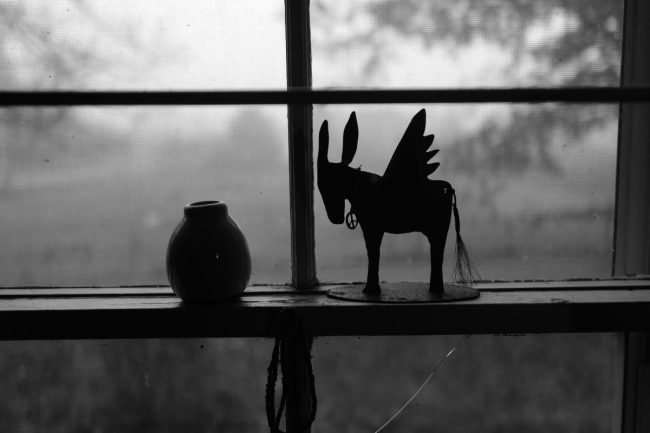My photo editing partner Andrew and I worked virtually – he enters my computer – on the Affinity Editing Program designed to work on photo editing with people on Apple devices.
The program has excellent reviews, but I find it complex and confusing, at least at first. Andrew and I are learning it together, he is teaching me. He is a computer whiz, and I am a photographer. It’s a good pairing.
This photo started as a black and white Leica picture of our Northern pasture window just before sunrise. The black and white photo below captured the power of a gloomy, cloudy.
On Affinity, Andrew discovered – and showed me – how to change the background to try to replicate sunrise. I thought this photo was unique in its power and emotion. Each photo captured a mood and feeling, and energy.
I’ve used photo editing programs for some time but always resisted altering photographs. How can anyone know what reality is?
But I’m softening on that.
They have their place; they help the photographer become a different kind of artist and a new kind of painter. My idea is to label altered photos, so people know the real ones from the altered ones. There can be no misrepresentation.
My Leica enables me to capture the emotion of black and white, Affinity may help me do the same for my digital color pictures.
I find this new technology very creative, and it adds a whole new dimension to my photography. They each reflect a different reality. And it raises the photos to the level of art at times.
This is the first teacher I’ve ever had who is so much fun to work with.



I love the warm light on the edited version–beautiful! And I admire you for delving into photo editing programs. I’ve had some training on photoshop and, while I know it’s a powerful tool in the right hands, I haven’t found it intuitive. Good choice to do it with a partner.
Huh! Interesting. I am wondering what other programs you have worked with? I used to be a photo journalist, when I was still in a healthy body. And my ‘app’ of choice was Photoshop. Used it for the longest time, not to change the images, but to do corrections and adjustments in colour and light. A while ago, Photoshop changed to a Cloud subscription program. I was dead against it because I felt it was a huge rip-off. I had invested a lot in Photoshop and now I could no longer independently own the product, but was forced to do a monthly subscription. They stopped developing the stand alone software, but I kept working with it for a good 3 years.
Then I exchanged my old Canon full frame equipment with top lenses to a much light camera of the Fuji X-series, mirrorless. And what a joy it was to work with it. Only one problem: their RAW images could not be read by my old Photoshop. To have that option, you can guess what I will write next: I had to come into the subscription program. Ultimately I did participate in that and I like all the new features.
But, in the 3 years that I stubbornly refused to accept the subscription I looked everywhere for an alternative. Did not find one. The one you are mentioning is new to me and I wonder how you are liking it. If you ever worked with Photoshop RAW/Photoshop editing, I wonder how it compares to that…
I will follow this thread and you keep shooting in the meantime. I love the images!
I loved Aperture the apple program, but they discontinued it..it’s the only one I ever worked with before Affinity..
As a post script about editing on computer:
I think that there is no shame in that at all. In the old days, in the dark room, I would do the same. Just in a technically different fashion. I adjusted exposure and light and saturation. That is what I do these days on computer as well. I might brighten a colour or remove a distracting object that I was unable to leave out of the shot. That kind of thing. Or, if you have to photograph a group of people, I will make sure that everyone shows up best, even if I have to copy and paste some faces from on photo into the other.
If I completely alter the picture, then I always mention that it was created with the use of something like Photoshop. In the end, you will always have the RAW files (in my case), that count as ‘negatives’ if I ever had to ‘prove’ that the shot captured the scene as it really was.
Another thing to take into account is that even with the very best digital cameras, all shots needs correcting. Even more so when you don’t work with RAW. When I did not have the equipment to do that, and had to rely on JPG, I was often stuck with a result that I did not really want. JPG formats not only compress the image, it also processes what the camera captures. So you already start with a lesser quality result. I know of fellow photographers who consider that ‘the challenge to get it right in the camera’. I agree that this should be your focus.
Only non-professionals have the time available to process all of their images that were improperly composed and stuff like that.
I attended a Zoom presentation with a wedding photographer, the other day, and she said that she only selects 10-20 photographs from each event to process herself. The rest is shipped off in RAW format to a third party that takes care of the routine stuff: sharpening, correcting exposure, and other things that she agrees on with them beforehand. She said she simply would never be able to deliver the end product if she had to do all the edits herself.